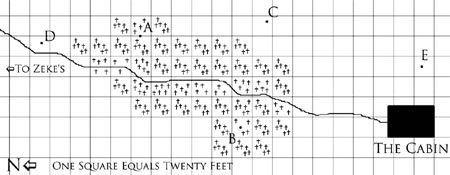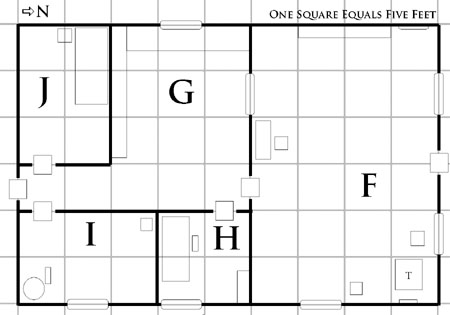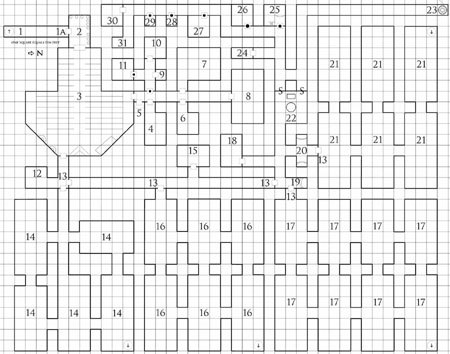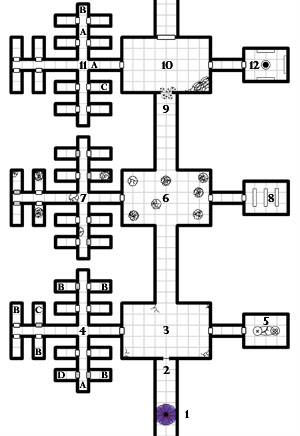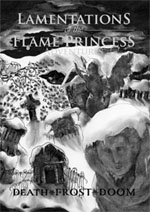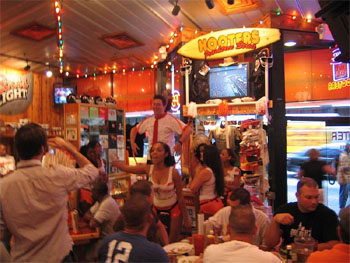
It looked absolutely nothing like this.
I usually don’t get heavy into personal biography around here, but I got married on Saturday. On the Wednesday before that, my brother and best man ran a session of OD&D for my small bachelor party. By means of celebrating my wedding, here are some highlights:
(1) John H. rolled up a cleric with 4 Intelligence. In addition to taking everything hilariously literally, he was also convinced that he was actually a wizard. (Even going so far as to dress up in pointy hat with stars on it.) He carried two wands — his small wand was a stick he’d found on the ground; his big wand was a mace (“a big stick with a big metal star”). Although he couldn’t cast any spells (being a 1st-level cleric), Andrew H.’s charcter (who was a magic user) would cast spells for him, thus supporting his delusion.
(2) David P. played Enriquill. Enriquill was a dashing fellow who insisted that the true joy of adventuring could only be found in “savoring the finer things”. For example, the exquisite delicacy which are the sightless eyeballs of giant bats. (He would also sample cave moss and lichen, leading us to discover the crude goblin carvings describing three pits as “Deep”, “Deeper”, and “Deepest”.) When Enriquill died towards the end of the evening, with his dying breath he gasped, “Eat my eyeballs…”
And we did.
(3) I played Matharl, a dwarf with golden eyes, silver skin, and copper hair (which he would cut once every three months for the profit). Matharl had once been a member of the Doge City of the Imperial Emperor 362. (Yes, the 362nd Doge City of the Dwarven Empire. We have delved deep. And wide. And also invested heavily in surface real estate.) But after contracting the metallo curse, he was exiled.
(4) We also had a newbie at the table who had never played an RPG before. He rolled some truly amazing ability scores, but then balanced out his luck by rolling a 3 on 3d6 to garner only 30 gp in starting cash. Trying to buy decent starting equipment with such meager funds was an exercise the whole table contributed to. We eventually got him decent armor (leather) and a weapon, but ran out of money before we could get him rations.
(5) Our newbie had also shown up late, so the rest of us were already in the dungeon. Our DM decided to start the newbie back at town. When he was presented with, “You’re in town. And out of food. What do you do?” His response was, literally, “Wait… This is how we do this?”
He was pretty consistently awesome throughout the entire evening. A little too eager to leap head-long down dungeon passages, but Matharl eventually resigned himself to that by simply keeping his ass as far back as he possibly could while the suicidal little runt went on his rampages.
(6) I say “runt” because in filling out his character sheet our newbie had created a 342 year old, 4′ 3″ , 184 pound human named Rico Suave. (Ricky II.) This was good, goofy fun. It was also great because the upper level of the DM’s dungeon was composed of tight passages that we were forced to crawl through (with branching tunnels that we eventually found led to the Deep, Deeper, and Deepest shafts mentioned above). While he’d insisted that everyone except my dwarf would be forced to remove their armor while crawling through these cramped passags, Rico Suave had inadvertently ended up being shorter and weighing less than I did. Ergo, he, too, was able to keep his armor on. This allowed us to travel down the passages front-to-back
(7) This prevented a repeat performance of an early disaster in which gremlins — little green balls with red-veined legs — had savaged Rico Suave from behind and stolen his food. Actually, that encounter probably would have ended okay if I hadn’t set the tunnel on fire.
(8) The session started when we received a mission from the sultan to rescue his harem. (A perfect scenario for a bachelor party game.) He offered us a 1,000 gp reward and then gave us the intel he had received from a palace guard who had followed the “swarthy, humanoid kidnappers” to a cave 4 days from the city. We couldn’t question the guard because the sultan had killed him to keep slanderous rumors from spreading about the loss of his harem…
… Matharl instantly realized that if the sultan was willing to kill his own guard for having even less information than we would once we returned the harem, that we probably wouldn’t be seeing that reward. On the other hand, there were 8 beautiful harem girls in a cave.
Before leaving town, though, we made a point of spreading rumors all over town that the sultan had lost his harem. We even mentioned the reward and the location of the cave. We figured there was a pretty good shot that other adventurers might show up, clear out the upper levels, and leave us with a clear shot at the harem girls.
(9) That didn’t happen, but it did set up the scenario by which Rico Suave joined the party. The DM staged a scene in which Rico Suave heard our 4 Int pseudo-wizard talking about the 1,000 gp reward. When he later showed up, though, we managed to convince both him and the 4 Int wizard that the reward was only 500 gp. (But we would totally split it evenly with them.)
THE BIG FINISH
After several perilous delves, we descended the Deepest shaft and found a metal plate. We knocked loudly and waited. When it opened, a pair of glowing eyes peered out from the darkness below. I wanted to know what it was, so I dropped my torch. The DM ruled that it landed pointy-end first, rolled for max damage, and ended up having the torch skewer the furry goblinoid straight through the forehead. He plopped down dead.
Rico Suave, naturally, leapt down to the corpse. He yanked the torch free and then looked around… to find himself surrounded by a ring of more furry goblinoids and several ettins, all looking at him in complete shock. Rico Suave looked up, “Uh… guys. There are a lot of them down here. I think–”
And then he was torn limb from limb.
Thinking quickly, Matharl called out in goblin, “Quick! Over this way! The vile murderer has jumped down this shaft!”
I was able to convince the ettins and goblins that Rico Suave had killed my father. We had pursued him into these caves seeking vengeance, which we were grateful they had given to us. They offered me the honor of chopping off his head. Which I did.
It turned out that they were in a celebratory mood themselves, having recently “fulfilled the prophecy” by sending a band to the “surface of the daybringer’s bright light” to capture “the veiled ones”. We managed to get ourselves invited back to a celebratory feast of prime Rico Suave meat. (Enriquill: “Always enjoy the finer things.”)
When we got to the feasting chamber, we found four of the harem girls huddled in a corner and quickly confirmed that the other four had already been eaten. (Apparently the dwarf girl was a good cook and had been forced to cook her friends.) Rico Suave wasn’t quite enough meat for all of us, so the ettins were getting ready to sacrifice another harem girl to the pot.
Matharl, thinking quickly, offered to first perform a sacred ritual of his people to thank the humanoids for fulfilling his vengeance and to bless their feast. Although one of the ettins fell to arguing with itself over the matter and one of the goblins looking a little suspicious, Matharl convinced them to kneel in a circle around the cooking fire. He said that the ritual would bring the power of the daystar into their hearts and then doused them with the holy oil.
And by “holy oil”, I mean “highly flammable oil”.
With the monsters doused, everybody lowered their torches and started a bonfire.
As we were leading the harem girls out, we discovered that some cryptic remarks the ettins had made earlier actually referred to sea serpents and green gelloid monsters. It was during the final battle against these creatures, holding the line while the harem girls escaped, that Enriquill fell.
But we emerged largely victorious. And since Enriquill was dead, we each had a harem girl for ourselves. Since the girls were pretty certain that the sultan was almost certainly going to kill us (even if we hadn’t let four of the girls get eaten before we saved them), and they weren’t particularly enthusiastic about going back to him anyway, we decided that we’d heard some wonderful things about the city of Waterdeep.
(The DM was surprised to learn that we had been in the Forgotten Realms this entire time.)
FURTHER READING
Reactions to OD&D
OD&D in the Caverns of Thracia

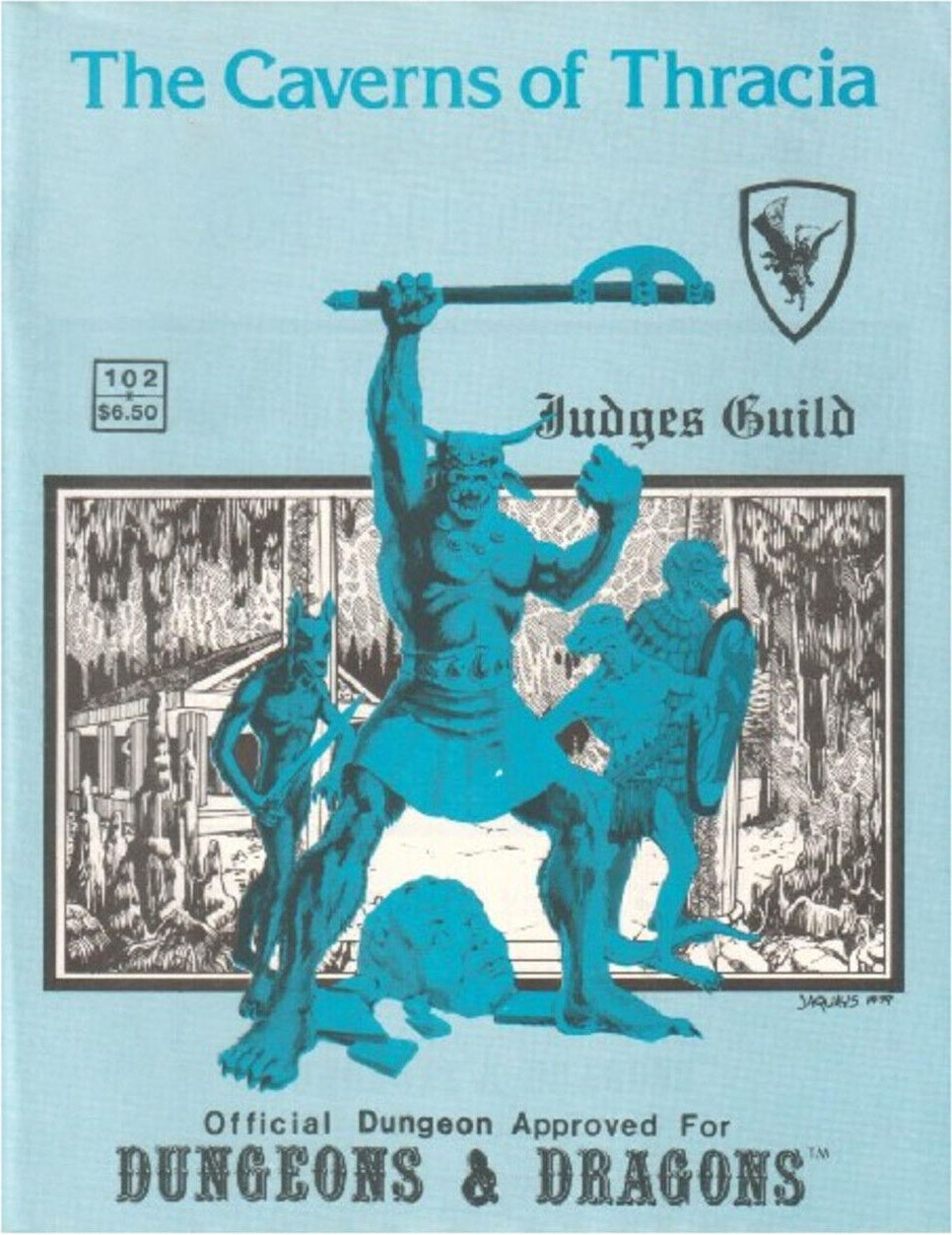
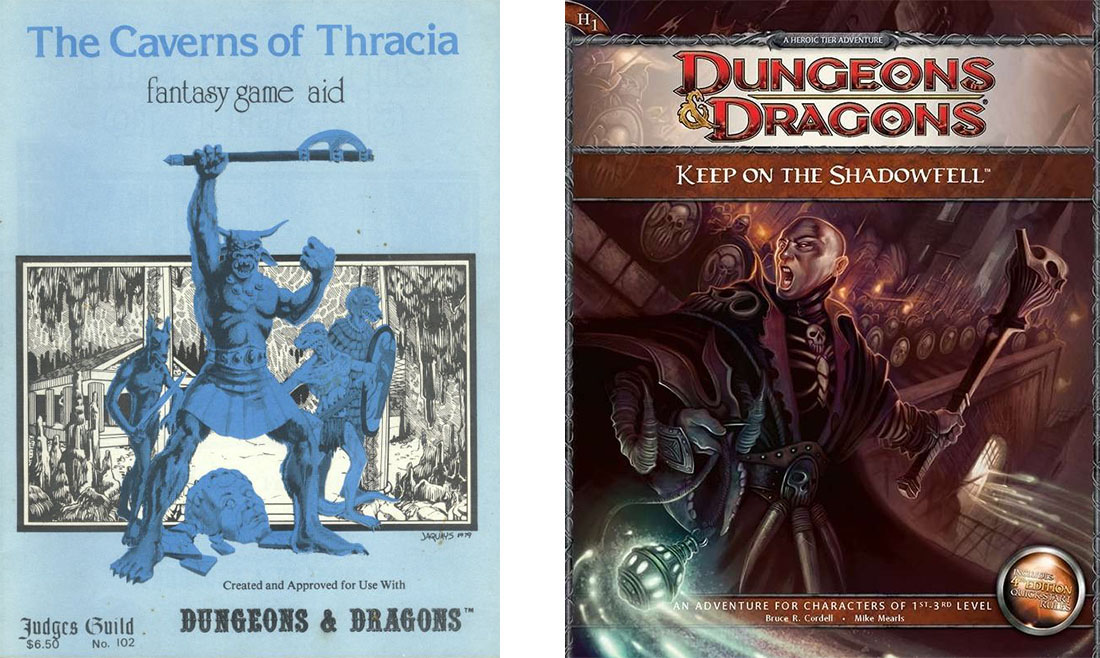
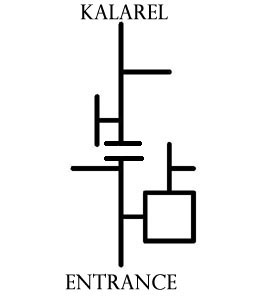
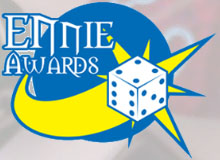 I was never really able to take the ENnie Awards seriously after they nominated the truly god-awful
I was never really able to take the ENnie Awards seriously after they nominated the truly god-awful 